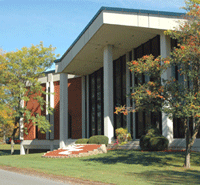Establishing a Typology of New York State School District Web Site Home Pages from a Public Relations Perspective
Paper submitted by:
Patricia Swann
Assistant Professor of Public Relations
Utica College
112 DePerno Hall
1600 Burrstone Road
Utica, New York 13502
E-mail: pswann@utica.edu
Richard Fenner, Ph.D.
Associate Professor of Economics
Utica College
123 DePerno Hall
1600 Burrstone Road
Utica, New York 13502
E-mail: rfenner@utica.edu
April 1, 2004
Establishing a Typology of New York State School District Web Site Home Pages from a Public Relations Perspective
Introduction
Public education in the United States is a vast enterprise, costing taxpayers $324 billion annually to educate 47 million students in the nation's 16,000 public school districts.1
In New York State alone, it takes about $35.19 billion in state, local and federal funds to educate 2.8 million students in 704 public school districts annually.2 The majority of funding for public schools in New York (51.4%) comes directly from local taxpayers.3
Because of the money involved, not to mention the important mission public schools fulfill in educating our nation?s children, schools play a central role in our communities. Positive public perceptions of schools, however, are mixed. Polls indicate that most Americans have "very little" or just "some" confidence in public schools overall.4 An annual poll by the national honor society Phi Delta Kappa and Gallup notes 48% of Americans assigned a grade of A or B to their community schools but when asked to grade schools overall, only 26% earned a B or higher.5
Since schools rely heavily on local support to achieve their mission, school districts must communicate effectively with various publics to inspire confidence in their efforts to educate children and to manage their financial resources responsibly. One of the tools schools have to communicate with their publics is the Internet.
Literature Review
The Internet - The Internet is a complex web comprising thousands of linked computer networks; it was established in 1969 by the U.S. Department of Defense as a means of inter-agency communication, especially in emergencies.6 As such, the Internet remained little known until the 1980s when the National Science Foundation's efforts resulted in the linkage of the government's network with other computer networks. This gave rise to commercial enterprises such as CompuServe and Prodigy, as well as America Online7.
The best-known and most often-used network on the Internet is the World Wide Web, or "the Web." A creation of the European Particle Physics Lab (CERN) in 1989,8 it was publicly launched in 1991; the rise of user interfaces (from software to browsers) in the 1990s made possible the addition of more complex graphic, video, and audio content. Such developments prompted a great many more consumers and businesses to connect to the more "user-friendly" Web. The Web uses a hypertext system to transmit text, graphics, sound, and video via telephone lines, cable transmission systems, and satellite.9
In the 1990s, consumer use of the Internet grew exponentially. In 1993, approximately 3,000,000 persons worldwide made use of the Internet; by the end of the decade that figure approached the 200-million mark.10 The total number of searchable Web pages is in the hundreds of millions; the Internet has become an important source of information and a communications vehicle for users on every continent, in every nation.
Computer and Internet access in homes has grown rapidly. More than half of households (54 million) had one or more computers and 42% had at least one member who used the Internet at home.11 According to the U.S. Census Bureau, "among people 3 years old or over, 36% used the Internet at home in 2000, including 18 million children 3 to 17 years, and 75 million adults 18 years old and over" in the United States.12
Internet Research - In part because of its rapid growth and its ready availability to researchers, the Internet has attracted considerable attention for its ability to inexpensively deliver information to mass audiences and more. What follows is a selection of research that looks at current user trends and some of the key Web features to consider when building a school district home page typology from a public relations perspective.
A survey of 2,000 people conducted by the Pew Internet and American Life Project found 60% used the Web regularly to get information; at least 80% expected to find reliable news, health care information and government services information on the Web.13 According to this study, Internet users said they were able to "satisfy their information needs" in the above categories most of the time (70%).
Another Pew Internet and the American Life Project study found that parents with children under 18 (70%) were more likely to have used the Internet than non-parents (53%). The study also found that parents were "generally more enthusiastic about technology and less burdened by technological change than non-parents."14
The "Media in Cyberspace Study," an annual survey that tracks journalists' use of the Internet, found that nearly 75% of the respondents went online daily and that half of the respondents used the Internet in the development of story ideas and article research.15
Beyond the Internet's growth and impact on nearly every segment of society, researchers have focused on other Internet issues including building relationships via the Web,16 Web site design and content,17 usability,18 and interactivity.19
Web interactivity and its particular role in building relationships, have received attention from public relations practitioners and researchers. Beyond one-way information delivery, the Web's interactive features such as e-mail, electronic bulletin boards, and chat rooms, can help build meaningful relationships through a two-way dialogue. Kent and Taylor describe dialogic communication as "any negotiated exchange of ideas and opinions two-way communication in which discussion, not agreement, is of primary importance." 20
Kent and Taylor suggested creating a "dialogic loop" using the Web's interactive features that "allows publics to query organizations and, more importantly, offers the organizations the opportunity to respond to questions, concerns and problems." 21 Web sites, according to Kent and Taylor, should also provide helpful information, not simply a visually appealing experience, to encourage and generate return visits. Further, the site's content on individual pages, especially the home or main page, must be sufficiently well organized and displayed to enable ease of navigation.22
Many researchers have investigated the concept of Web site interactivity. McMillian and Hwang noted interactivity could be categorized by process (interchange and responsiveness), features (user control and two-way communication using search engines and chat rooms), and the user's perception of interactivity (direction of communication, user control and time).23
While most research has focused on specific features and characteristics of the Web (interactivity, design, content, and publics), Esrock and Leichty created a workable typology for describing corporate Web sites as a whole. Their work established baselines for future researchers to further evaluate how well organizations are doing in meeting selective criteria. This study also sought to establish a typology for school district Web sites as a foundation for further examination since relatively little research has been done in this area.
Esrock and Leichty's two-stage study of 100 Fortune 500 corporate Web sites examined publics served, content variety, and various features (navigational tools and interactivity functions).
For example, they found an overwhelming majority (85%) of the sites analyzed had communication aimed at two or more audiences while more than a third of the sites had expansive content, using the Web in an "energetic manner." 24 These sites spoke to several publics in various ways and were organized so that the news media could gain access to corporate news releases (88%) and other useful information (product/service catalogues, 92%, and profile/history, 90%).Many sites with news releases included an archive of such material dating back more than a year.25 Sites designed to serve multiple audiences provided a significant range of content choice.26
Although the use of multi-media applications on many commercial Web sites is increasingly evident, corporate Web sites in Esrock and Leichty's sample emphasized textual and graphic content without audio and video support, whether the information presented was intended for the media or for other site visitors.27 Many sites provided an e-mail link (75%). For navigation, corporate home pages often included a site map or index (46%), a search engine (47%), or both (about one-third).28
Public School Web Sites - A study by the U.S. Department of Education found 75% of public schools had a Web site in 2001.29 About 75% of these sites contained a schedule of events/school calendar, staff director (73%), information on programs and classes (70%), information for parents (64%) links to Web sites for educational tools for students (61%), information on sports and/or clubs (58%), school policies/rules (52%) and links to middle/high school buildings (50%).
More than 50% of schools with a Web site reported that parents and students could communicate with the school via the site and 63% reported that the Web site was updated at least monthly. The study also reported that among 75% of schools with a Web site, 41% reported that students had participated in the creation and 31% had participated in its maintenance. In addition, in 57% of the schools, students contributed materials on the Web site.
The growth of school district Web sites in New York coincides with the dramatic use of the Internet and the World Wide Web, which accelerated in the 1990s. Nearly all 704 public school districts in New York today have a Web site presence. Clearly, New York school districts recognize the value of having a Web presence to communicate information.
Research Questions
To establish a workable typology of school district Web sites, a variety of questions emerged. What key publics have districts chosen to communicate via their Web sites? What information gets prominence on the Web site's most valued piece of "real estate," its home page? How are school districts using this inexpensive yet powerful interactive communication tool? What kind of experience does a user get? Does the site provide ways to interact (two-way) with the district? Is it easy to find information? Is the information fresh? Is it visual?
This research attempted to establish a basic topology of New York State school district Web site home pages as a starting point for future research into how school districts are using this important technology.
This study examined if school districts organized or segmented (customized) their home page information for certain key publics (students, parents, teachers/staff, prospective employees, alumni, community, journalists and volunteers) in order to address their specific information needs. What types of information were given prominence on school district home pages with hyperlinks (text links, larger text or iconic buttons, pull-down menus or full text messages)?
This study also examined some of the usability and interactivity features that can contribute to a user's positive experience using a school district Web. Interactive features such as site navigation tools (search engines and site maps) that help users find information easily, e-mail responsiveness, and a notification of how recently the information had been updated on the site (information immediacy) were examined. The presence of visual communication elements was also examined.
The research questions proposed included:
RQ1: What publics are served by school district Web home page?
RQ2: What types of information are given prominence on school district Web site home pages?
RQ3: What interactive and navigational features are present?
RQ4: Are school district Web sites responsive to users?
RQ5: What visual elements are present on Web site home pages?
Methodology
As Kimberly Neuendorf noted in "The Content Analysis Guidebook," Web site content analysis is the "new kid on the block" and provides ample opportunities for mediated message research.30 However, Web sites can pose problems for the researcher due to the endless array of features, dynamism, size, and complexity.31
To avoid those potential problems, the unit of analysis was limited to the district's Web site home page. This excluded "gateway" or introductory pages, which are usually characterized by a large graphic and the name of the school district.
Sampling Frame
This study analyzed the characteristics of 137 (19%) New York State public school district Web sites. New York City was excluded in this study because of its unique organizational structure that includes 10 regional school zones containing approximately 120 schools within each zone.
The sampling frame for this study came from a list of New York State school districts listed alphabetically on the State Education Department's Elementary, Middle, Secondary and Continuing Education Web site as of April 2003.32 A stratified systematic sample included 137 districts from this list, with every fifth case picked after a random start of 30. Each district's Web site was located in most cases off the state's Board of Cooperative Educational Services (BOCES) 18 Regional Information Centers (RIC) Web sites.33 If the site location was not listed or the Web address on the RIC pages was not accurate, the researchers attempted to find the district page by entering the district's name into the Google Internet search engine.
Reliability
Web sites for this study were electronically archived using Grab-a-Site 5.0 software by Blue Squirrel and copied to compact disk during the first week of September 2003 so booth coders viewed the same material.
Grab-a-Site software is a file-based offline browser that allows the user to download entire Web sites while retaining the original filenames and directory structure. The software allows the export of Web sites as complete mirror copies, including movies (MOV, AVI), pictures (JPG), documents (PDF), program (EXE) or archive (ZIP) to CD in minutes. This made it easy to overcome the potential data collection and coding problems identified by McMillan about the dynamic nature of Web.34 The Web content examined included school district home pages down to the fifth level of the sites' hierarchy.
Two coders participated in the coding process. To obtain intercoder reliability, coders were trained using five non-sampled sites. Cross coding was conducted on 10% of the sample Web sites together. The intercoder reliability for the selected sample coding yielded reliability coefficients ranging from .88 to .90; the reliability coefficient calculation formula used is from Holtsi.35 Based on these results, the other 137 sites were coded for 52 surface-level items.
Coding
Each school district's Web site homepage was coded according to the items identified in a codebook. The presence or absence of different features and types of content was recorded, but no interpretation of the substantive meanings of the features or page content was made. Coders looked for button icons, which included pull-down menus, clickable or rollover-pop-up buttons, underlined text links, or full display of textual information.
Coding for District Characteristics: Enrollment, Type and Need - Using information provided by the New York State Education Department's Office of Elementary and Secondary Schools and its Web site, each district was coded for size based on total K-12 enrollment, geographic type (rural, suburban and urban), and educational need, based on SED's need-to-resource-capacity (N/RC) index, a measure of the district's ability to meet the needs of its students with local resources.36
Coding for Specific Publics - Each site was coded for the presence of special areas or sections that were devoted to a general audience and eight specific publics: students, parents, teachers/staff, alumni, community/residents, prospective employees, journalists, and volunteers. This coding included overt hyperlinks on the Web page or special section areas of the site that had either the exact description of these groups or analogous terms. Coders were allowed to make inferences about a label if they thought it accurately fit with a particular audience.
Coding for General Content - Based on a review of traditional school district newsletters and an initial sample of district Web sites, 24 items were coded to capture the substantive content of school Web sites that would appeal to its varied audiences.
Items included: district's postal address, telephone phone number, fax number, district e-mail address (general), and Webmaster e-mail address, directions to district, mission/vision statement, district/information profile, board of education, central administration, calendar of events, news/announcements, district newsletters (electronic versions), building projects information.
Other areas of content coded included: Academic information, before and after school programs, transportation/bus routes, school lunch menu, special education, guidance information, health/nurse information, school policies, school building links, sports/athletics, club information.
Coding for Technical Elements - Because of the interactive communication features of Web sites, organizations can move beyond simple message dissemination and engage their publics in meaningful discussion. One of the principles of dialogic communication is the ability to carry out two-way virtual conversation to build relationships with publics through a "dialogic loop." Four interactive communication features were coded in this study including e-mail, bulletin/message boards, chat rooms, and instant messaging. Also, a presence of a statement of when the site was last updated was coded.
Technical communication elements that can encourage the dialogic loop included electronic academic classroom management systems, electronic bulletin boards, electronic chat rooms, instant messaging, site search engines, site maps, and off-site hyperlinks.
Electronic academic classroom management systems for this study included systems such as Blackboard, which allow students and parents to check assignments, grades, and many other informational items related to classroom activities.
Computer bulletin boards allow message postings (a user can read notes or messages of other users or type in his or her own messages to be read by other users.) Bulletin boards can also have several separate "areas" for messages related to different topics.
Chat rooms are areas of the World Wide Web where users can interact in real-time with each other by leaving messages. Often users must sign up for the service. Users are given a user name (normally of the person's choosing) that identifies the person in the chat room. Once logged on to the chat room a user can type a message in an input box and this message is then displayed in the chat room window for other chat room users to view and respond to.
Related to the idea of dialogic communication and building relationships through the Web is the concept of "generation of return visits." 37 Kent and Taylor explained "sites that contain limited/unchanging information are no longer useful after one visit and do not encourage return visits." They suggested updating the information frequently as one way to encourage return visits and build relationships. Statements on the home page that indicated when the site was last updated were measured.
Another feature examined was the presence of off-site hyperlinks. Most Web sites use hyperlinks to connect the user to specific information within the Web site but these links can connect to other Web sites. Kent and Taylor saw off-site hyperlinks as potentially detrimental to establishing dialogic relationships. "Once a visitor leaves your site on a 'link,' s/he may never get back." 38 This study noted school district home pages with off-site links.
Two technical elements that promote the usability of Web sites, internal search engines and site maps, were included in this study. Internal search engines make it easier for users to find what they are looking for by typing in key words to locate information within the site. This makes sense, as many sites can be hundreds of pages. An internal search engine that is built into a Web site generally uses the same architecture as an external search engine, such as Google.com.
Another electronic feature examined included the presence of a Web site map which is a graphical representation of the website. It resembles a basic table of contents and shows the navigational path of hyperlinks within a site.
Another "ease of use" feature checked for was the presence of a "home" button to aid users in easily navigating back to the home page.
Coding for Visual Elements - While Web site design was not a focus of this study, graphics as a visual communication mechanism were included to establish a baseline for a school Web site topology. Coding of graphics elements included text crawls, clip art, school logos and athletic logos, as well as photographs of school buildings, students, and other subjects.
Indexes - Using the coded items for publics, content, technical elements, and visual elements four indexes were constructed to explore relationships with other variables.
Results
Ninety-six percent of the school districts studied had Web sites, although technical problems (site errors or "under construction") prevented access to four sites. Four school districts did not have a locatable Web address. The sample included 40 rural, 84 suburban and 13 urban school districts. Districts ranged in enrollment from 22, for a specialized school district, to nearly 12,000. The medium school district enrollment was 1,645.
Table 1 District Type (Click all to enlarge)

Table 2 Resource Capacity

Table 3 District Enrollments
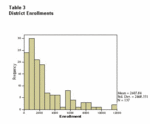
RQ1: What publics are served by school district Web home pages?
This study examined if school districts segmented and addressed specific publics through the prominent use of hyperlinked iconic buttons, text buttons, text links, pull-down menus (which can create segmented information areas) or full-text information displays on the home page. Coders looked for specifically labeled hyperlink buttons for "students," "parents" (or PTA, PTO, etc.), "alumni," "teachers/staff" (or employees, etc.), "prospective employees" (or jobs, etc.), "community," "volunteers" (or boosters) and "journalists" (or news media). Coders did not count publics that were "nested" within a pull-down menu, "roll-over" pop-up menu buttons or added to a second-level (off the home page) hyperlink page.
Seventy-seven percent of the sites did have at least one home page link, button or pull-down menu for one of eight key publics. The most common public that districts highlighted was prospective employees (44%), followed by community (33%), alumni (29%), parents (26%), teachers/staff (22%), students (12%), journalists (5%) and volunteers (4%). The criteria for assessing links for journalists included news releases, not merely "news" or "announcements" that are characterized by their brevity, lack of media contact information and news release archives.
Table 4 Publics Segmented by District Web Site
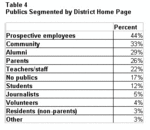
Table 5 Public Index
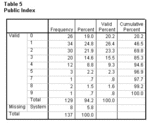
Web sites that served several publics also had more information variety. A correlation of "publics" and "content variety" indexes was significant (r = .31, p<.01). There was no significant relationship between the "publics" and "technical features" indexes.
Table 6 Public and Content Variety Indexes Correlation

The results of a cross tabulation with Publics Index and District Type breaks down the number of publics with the district type (rural, suburban, and urban). This data reflects that rural districts are not segmenting their publics as often has the suburban and urban districts.
Table 7 Public and District Type Cross Tabulation

Another cross tabulation of the Publics Index and Resource Capacity (a measure of the district's ability to meet the needs of its students with local resources) shows that high need rural districts are not as likely to segment their home pages for specific publics.
RQ2: What types of information are given prominence on school district Web site home pages?
Ninety-eight percent of the school district Web site home pages provided information content beyond identifying the name of the school. The most common type of information provided in either hyperlinked or full-text format were links to school buildings (69%) or a calendar of events (67%). The district's telephone number was provided on 62% of the sites.
Other types of information that were regularly featured on school district home pages included: district information/profile (57%), board of education (57%), central administration (54%), sports/athletics (50%) and full postal address (50%), news announcements (42%), academic information (40%), school lunch menu (35%), school policies including weather closings (33%), mission and vision statement, information, (26%), fax number (22%), electronic newsletters (19%), building project updates (18%), bus routes (14%), guidance (13%), directions (12%), clubs (12%), health/nurse (7%), special education (7%), and before-and-after school programs (3%).
Some of the "other" content included links for school library, information and technology, teacher centers, school safety, adult/community education, school report cards, student or teacher Web pages, and foundations.
Table 8 Home Page General Content

Table 9 Content Index
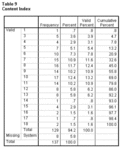
Web sites that with a variety of content also had more technical features. A correlation of "content variety" and "technical elements" was significant (r = .31, p <.01).
Table 10 Content Index and Technical Elements

RQ3: Technical Elements: What interactive and navigational features are present?
E-mail was the dominant interactive feature on school district home pages with 34% of sites providing a general e-mail text link and 43% providing a Webmaster e-mail link to provide comments or ask questions about the Web site. To keep users returning to the site, a statement of when the site was last updated is helpful because it indicates the news is fresh and up to date. This statement was present in 30% of the sites.
Off-site hyperlinks to "cool" or useful sites may encourage return visits but only to take visitors away from the site, which may discourage building relationships. Off-site links were present on 28% home pages.
Six percent of the sites provided a link for their classroom management systems, such as Blackboard. None of the sites had bulletin boards, chat rooms or instant messaging features on the home pages.
More than a third of the sites had a "home" button that aids navigation of the site. Other helpful features to find information easily included the presence of a search engine (23%) and site maps (13%). There were no relationships between
Table 11 Technical Elements
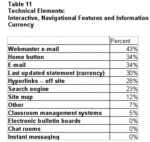
RQ4: Are school district Web sites responsive to users?
School district responsiveness to users was measured by responses to e-mail requests for general information. As mentioned in the content section above, an e-mail address was present on 34% of home pages. Webmaster e-mail addresses were on 44% of district home pages, although these links generally tell viewers that they are intended primarily to report problems or suggestions for the site itself. Coders looked for an e-mail address from the home page and, if none was available, the coder was then allowed to seek an e-mail address from other linked pages. Seventy-three e-mails (50% of sample) were sent to districts and generated 37 e-mail responses, a response rate of 53%.
Table 12 E-mail Response

RQ5: What visual elements are present on Web site home pages?
Ninety-seven percent of the sites had some graphic element. The most common visual element was photographs (75%) including photos of school buildings (36%), students (20%) and other subjects (19%). Clip art was used on 38% of sites, followed by the presence of school logos (25%), and athletic logos (16%). Other graphic design features included animation (12%) and text crawls (12%).
Table 13 Visual Elements
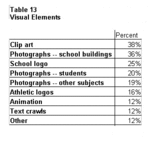
Discussion
As is the case with more traditional communication, a school district Web site should inform its various publics as well as develop and maintain positive relationships with them. Beyond its practical value as a delivery system for information, the school district Web site?'s greater value may be the rapid interactive capabilities that make possible meaningful dialogue between individuals within the district hierarchy and various publics, e.g., parents, district residents, taxpayers and others.
Any of the organizational Web sites examined in this research has the potential to become a kind of virtual community: a place where dialogic communication helps build a sense of community that engenders relationship building. Cyberspace, as it has come to be known, is in fact not one "space," but many. "Communities, exchange, and conversation all flourish in a certain type of space; they are extinguished in a different type of space." 39
Because of its potential for interactivity, the Internet offers organizations means of engaging and developing relationships with key constituencies, but the extent to which interactivity fosters such relationships depends on the design of the site and the quality of the interactive experience.40
Nearly all school districts in this study had a Web presence, (much higher than the national level of 75%) which indicates New York school districts recognize the power of the Internet as an effective, low-cost message dissemination tool. School Web site home pages also were content rich, often far exceeding the 51 coded items of this study's protocol.
From a public relations perspective, schools could do a better job of identifying their key publics and creating specialized areas with tailored information to better address their needs. The idea of tailoring messages for key publics on a home page is a common strategy of public relations practitioners but if Web sites are created and maintained primarily by the district's technology coordinator or even students, the concept of segmenting publics may be an unfamiliar one.
Pull-down menus or "roll-over" pop-up menus are both effective techniques to segment publics. Labeling these buttons or specialized areas for various publics, even when some information is duplicated in more than one spot, will make the site easier to find information from the end-user's perspective.
Of particular interest was the near absence of information tailored specifically for journalists. While 42% of sites did some form of news/announcements on their home pages, only 5% packaged the information specifically for journalists' needs (including news releases, news release archives, backgrounders, fact sheets, and media contact information). With 75% of journalists today using the Internet on a daily basis to do their work, schools should take advantage of this opportunity to develop an active media relations program via the district Web site. In addition, schools should include in their crisis plans use of the Internet to provide a constant flow of available information for all key publics as well as an on-line newsroom for the news media.
Volunteers as a public (4%) may have been low because parents are typically volunteers within the schools. Parents can belong to volunteer organizations such as PTAs, PTOs, PTSEA, and extracurricular booster organizations and, as such, might be part of the same construct as parents.
Students, a primary public of any school, also ranked low in prominence on district home pages (12%). Students should be treated as a public with unique information needs. As a primary user of school services (not to mention their inclination to use the Internet for information searches and e-mail communication), schools should recognize this group (according to building levels) and create opportunities for students to access academic support services (tutoring, homework hotlines, homework assignments, notes, etc.) and be involved in school extracurricular activities.
Much of the content coded for this study could be organized (and duplicated for each public, if necessary) within the suggested eight key public segmented areas to streamline the home page's design. This would make navigation easier for the user. Some sites had more than 70 small text links on their home pages, which meant time-consuming searches for the user.
In addition to organizing and segmenting information according to key publics on the home page, schools may want to consider their approach to the Internet's interactive features to build meaningful (dialogic) relationships with key publics. Just 34% of sites had e-mail links or a contact button on the home page. Because studies show that parents and students are heavy users of e-mail, districts should consider providing an e-mail link or a "contact us" staff directory button (including the staff members' names, titles, phone numbers) on the home page. E-mail provides parents the flexibility of communicating with school officials during and after business hours. The 53% response rate based on 73 e-mail inquiries could improve. Schools should make responding to e-mail inquiries a priority since this technology is gaining in popularity.
There was no evidence of computer bulletin boards or chat rooms on school home pages in this study. For some key publics, such as parents, alumni, teachers/staff and volunteers, a regulated use (with user registration safeguards) of these interactive technologies could bring users back to the site regularly.
Navigational features such as "home" buttons (34%), search engines (23%) and site maps (12%) all help make the user's experience productive and should be included to encourage return visits. Another feature that encourages return visits is a statement of how recently the site has been updated.
The use of student photos on Web home page (20%), while visually interesting, can pose problems involving privacy and confidentiality regulations. For students under the age of 18, schools should get written permission from their parents or legal guardians. Another option is the use of "stock" photography.
Limitations
This research examined 137 school districts in New York State and, as such, is not necessarily representative of the 16,000 districts across the United States. Another limitation of this study is the absence of the New York City school system, which represents 1.1 million students in the state. The absence of such a major presence in the state education system does not adequately portray the full story of school district Web sites in New York. Also, the stratified random sample did not include any large city school districts (Buffalo, Rochester, Syracuse, Albany and Yonkers.)
The study was limited to school district front/"home" pages and, as such, only represents a small fraction of the content available for study. In fact, content "nested" within buttons or pull-down menus was also excluded from this study since the goal was to determine what information, as well as what key publics, was given prominence, and therefore importance by the organization and design of the Web home page.
References:
1) National Center for Education Statistics, "Digest of Education Statistics, 2002," http://nces.ed.gov
2) The University of the State of New York, The State Education Department, "Education in New York State 2002," Albany, NY. Also accessible at www.nysed.gov.
3) The University of the State of New York, The State Education Department , Office of Elementary and Secondary Schools, "New York A State of Learning," 2002, Albany, NY, June 2002.
4) The Gallup Organization, "Giving and Volunteering in the United States," 1991
5) "The 35th Annual Phi Delta Kappa/Gallup Poll of the Public's Attitudes Toward Public Schools," Lowell C. Rose and Alec M. Gallup, September 2003.
6) Ibid., http://www.isoc.org/internet-history/brief.html
7) Ibid., http://www.isoc.org/internet-history/brief.html
8) Ibid., http://www.isoc.org/internet-history/brief.html
9) Ibid., http://www.isoc.org/internet-history/brief.html
10) Ibid., http://www.isoc.org/internet-history/brief.html
11) U.S. Census Bureau, "Home Computers and Internet Use in the United States: August 2000."
12) U.S. Census Bureau, "Home Computers and Internet Use in the United States: August 2000."
13) J.B. Horrigan and L.Rainie, Pew Internet & American Life Project, "Counting on the Internet," 2002.
14) Pew Internet and American Life Project, "Parents Online," 2002.
15) S. Ross and D. Middleberg, "1999 Media in Cyberspace Study."
16) M. L. Kent and M. Taylor, "Building Dialogic Relationships Through the World Wide Web," Public Relations Review, 24(3) (fall 1998): 321-334.;
M. Taylor, M. Kent, W. White, "How Activist Organizations are Using the Internet to Build Relationships," Public Relations Review 27 (2001): 263-284.
17) R. Solberg, "Creating a Web Page Demands Smart Design," Interactive PR 1(30) (August 15, 1995);
M.L. Kent, "Does your Web Site Attract or Repel Customers" Three Tests of Web Site Effectiveness,' Public Relations Quarterly, 43(3) (1998-99) 31-33;
S. Holtz, "Public Relations on the Net: Winning Strategies to Inform, & Influence the Media, the Investment Community, the Government, the Public, & More," American Management Association, (NY, New York, AMACOM, 2002);
D. Siegel, "Creating Killer Web Sites: The Art of Third Generation Site Design," 2 nd Ed., Hayden Books, MacMillan Publishing Company, Indianapolis Ind. (September 18, 1997).
18) K. Hallahan, "Improving Public Relations Web Sites Through Usability Research," Public Relations Review, 27(2001): 223-239.
19) M.J. Paul , "Interactive Disaster Communication on the Internet: A Content Analysis of Sixty-Four Disaster Relief Home Pages," Journalism and Mass Communication Quarterly, 78(4) (winter 2001): 739-753
C. Heeter, "Implications of New Interactive Technologies for Conceptualizing Communication," in Media Use in the Information Age: Emerging Patterns of Adoption and Consumer Use in the Information Age: Emerging Patterns of Adoption and Consumer Use, ed. J.L. Salvaggio and J. Bryant (Hillsdale, NJ: Lawrence Erlbaum Associates, Inc., 1989), 217-35;
B. Massey and M. Levy, "Interactivity, Online Journalism, and English-Language Web Newspapers in Asia," Journalism & Mass Communications Quarterly 76 (spring 1999): 138-51;
L. Ha and J.E. Lincoln, "Interactivity Reexamined: A Baseline Analysis of Early Business Web Sites," Journal of Broadcasting & Electronic Media 42 (4, 1998): 456-74.
20) M. L. Kent and M. Taylor, "Building Dialogic Relationships Through the World Wide Web," Public Relations Review, 24(3) (fall 1998): 321-334.
21) Ibid., 321-334.
22) Ibid., 321-334.
23) S.J. McMillian, J.S.Hwang, "Measures of Perceived Interactivity: An Exploration of the Role of Direction of Communication, User Control, and Tiem in Shaping Perceptions of Interativity," Journal of Advertising 5(2) (2000): 9-21.
24) S. Esrock and G.B. Leichty, "Organization of Corporate Web Pages: Publics and Functions," Public Relations Review, 26(3) (fall 2000): 327-344;
"Corporate World Wide Web Pages: Serving the News Media and Other Publics," Journalism and Mass Communication Quarterly 76 (3) (fall 1999): 456-467.
25) Ibid., 461
26) Ibid., 462
27) Ibid., 461
28) Ibid., 461
29) National Center for Education Statistics, "Internet Access in U.S. Public Schools and Classrooms: 1994-2001," September 2002.
30) K. Neuendorf , "The Content Analysis Guidebook," p. 206-207, Sage Publications, Inc., Thousand Oaks, Calif., 2002.
31) S. J. McMillan, "The Microscope and the Moving Target: The Challenge of Applying a Stable Research Technique to a Dynamic Communication Environment," 77(1) (spring 2000), Journalism and Mass Communication Quarterly: 80-98.
32) New York State Education Department, available online http://www.nysed.gov/admin/admindex.html
33) Regional Information Centers are part of Boards of Cooperative Education Services which are public organizations created by the New York State Legislature in 1948 to provide shared educational programs and services to school districts.
34) S. J. McMillan, "The Microscope and the Moving Target," 92.
35) O.R. Holsti, "Content Analysis for the Social Sciences and Humanities," 1969, Reading, MA: Addison-Wesley.
36) The University of the State of New York, The State Education Department , Office of Elementary and Secondary Schools' Web site: http://www.emsc.nysed.gov/
37) Kent and Taylor, 1998, p. 329.
38) Kent and Taylor, 1998, p. 330.
39) L. Lessig, "Code and Other Laws of Cyberspace," Basic Books, NY, NY, 1999.
40) M.J. Paul , "Interactive Disaster Communication on the Internet: A Content Analysis of Sixty-Four Disaster Relief Home Pages," Journalism and Mass Communication Quarterly, 78(4) (winter 2001): 739-753.



